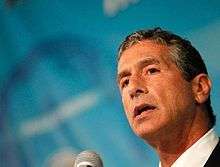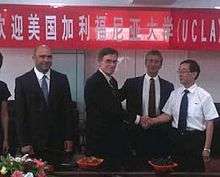Michael Silver (CEO)
| Michael N. Silver | |
|---|---|
 | |
| Born | May 10, 1955 |
| Residence | Los Angeles, California |
| Nationality | American |
| Alma mater | University of Southern California |
| Occupation | Materials Science Entrepreneur & Inventor |
| Organization |
Chairman & CEO, American Elements Trustee, Natural History Museum of Los Angeles County |
| Known for |
Founder of American Elements Materials Science Pioneer Rare Earths & Inner Mongolia Philanthropy |
Michael Nathan Silver (born May 10, 1955) is a business executive, philanthropist, art collector, and commentator. He is the founder and CEO of American Elements,[1] a global high-technology materials manufacturer. He was instrumental in establishing the post-Cold War rare earth supply chain from Inner Mongolia to the U.S. and Europe. His philanthropy includes sponsoring over 1,000 materials science and green technology conferences[2] and educational television programs on high technology and contributing funding to the arts. He is a trustee of the Natural History Museum of Los Angeles County and serves on the board of directors of several art museums including the Institute of Contemporary Art in Los Angeles, CA. He writes and speaks on issues affecting the global high technology industry,[3] science education[4] and Sino-American relations.[5][6]
Early life and education
Michael Silver was born and raised in Los Angeles, California. He attended the University of Southern California (USC) receiving a B.A. degree in behavioral neuroscience in 1978 and then attended USC’s JD/MBA dual degree program graduating in 1982. He practiced corporate law for 10 years, specializing in mergers & acquisitions.[2]
Business career

In the mid-1990s Silver founded American Elements as a manufacturer and metals refiner of rare earths and other critical metals serving U.S. industry. Upon the near simultaneous closing of Unocal/Molycorp in Mountain Pass, California and the Rhodia rare earth refinery in Freeport, Texas, ending U.S. rare earths metal production, he flew to Baotou, Inner Mongolia and established one of the first post-Cold War supply chains from Inner Mongolia directly to industrial end users in the U.S., Europe and Japan. Over the next 15 years he built American Elements facilities in Salt Lake City, Utah; Monterrey, Mexico; Baotou, China; and Manchester, England and expanded production to include newly discovered elemental forms of advanced materials such as nanoparticles,[7] green technology & alternative energy materials[8] and advanced military alloys.[9]
Philanthropic activities
Silver established the not-for-profit American Elements' Academics & Periodicals Department in 2006 to support high school, college and graduate school education in high technology and materials science.[2] Since its founding, the Department has sponsored over 1,000 academic and industry conferences in 25 countries in fields such as space exploration,[10] nanotechnology,[11] green technologies,[12] solar energy[12] and robotics.[13] In 2011, it co-sponsored with the National Science Foundation a four-part PBS TV series on NOVA entitled "Making Stuff" examining the world of materials science.[14] Silver funded and hosted a delegation in 2011 from the UCLA Medical Center in Los Angeles, California to the Inner Mongolian Medical Teaching College in Baotou, China which has led to student and teacher exchanges and the development of a joint AIDS program. He is a trustee of the Natural History Museum of Los Angeles County and a member of the Board of Directors of the Institute of Contemporary Art, Los Angeles and the Sarara Initiative in Northern Kenya and the council of the Getty Research Institute in Los Angeles. He also serves on the council for the Getty Villa in Malibu and has underwritten artists in residence at the UCLA Hammer Museum. He has made in-kind donations of artwork to the National Museum of African American History & Culture in Washington, DC.[15]
Writing and speeches
Silver writes and speaks on several topics including:
- American Global Competitiveness in High Technology
- The Physical and Geo-Political Scarcity of Critical Metals
- Environmentalism and Green Technology
- Ways to Promote Better Sino-American Relations
- Geopolitics and global natural resources including minerals in Afghanistan[16] and North Korean uranium[17]
In 2010, Silver coined the phrases “Innovation Distortion”[18] to describe efforts to avoid the use of a given element solely because of concerns that it may be hoarded by nations with resource control of that material and “The Environmentalism Catch-22” to describe the dilemma faced by the environmental movement which both supports a green technology future reliant on solar energy, wind power, electric cars and fuel cells and concurrently opposes the mining of the critical metals from which these technologies are manufactured.[19] In October 2014, Silver's editorial discussing these ideas was published in the Wall Street Journal.[20]
Silver coined the phrase "Sovereign Monopolies" to describe nations that have a sufficient percent of the world's reserves of a given metal or mineral that they can dictate its cost and force industries requiring the metal to move production to their country to obtain preferential pricing.[21]
References
- ↑ Bloomberg (2014-08-08). "Bloomberg West, Interview with Corey Johnson, August 8, 2014". Bloomberg.
- 1 2 3 "OSA Executive Series, Steve Jacobs interviews Michael Silver". Osa.org. June 27, 2012. Retrieved 2014-08-04.
- ↑ "American Elements CEO Commenting on WTO Rare Earth Action". Ntdtv.com. 2012-03-14. Retrieved 2014-08-04.
- ↑ "Larry O'Connor Show - Mike Silver Interview". Blogtalkradio.com. 2011-11-30. Retrieved 2014-08-04.
- ↑ "Rare Earth Junior Miners Should Applaud China". Community.nasdaq.com. 2012-05-22. Retrieved 2018-03-21.
- ↑ "Business Delegates Lambast China's Rare Earth Mineral Restrictions". New Tang Dynasty Television. 2011-09-16. Retrieved 2018-03-21.
- ↑ "American Elements announces I-MITE™ Indium nanoparticles for next generation transparent anti-static packaging and coatings". Nanotechnology News. 2008-08-29.
- ↑ RenewableEnergyWorld.com (2007-03-16). "American Elements announces new AE Solar Energy™ Product Group, Renewable Energy World - March 16, 2007". Renewableenergyworld.com. Retrieved 2014-08-04.
- ↑ "American Elements announces new technological advance in precious metal foil manufacturing," Industrial Manufacturing News - May 4, 2007 Archived May 24, 2008, at the Wayback Machine.
- ↑ ISROS Sponsors Archived April 24, 2012, at the Wayback Machine.
- ↑ "NanoMed Sponsors". Nanomed.uk.com. Retrieved 2014-08-04.
- 1 2 "SPIE Sponsors". Asmeconferences.org. Retrieved 2014-08-04.
- ↑ "Magnesium 2012 Sponsors".
- ↑ "NOVA | Making Stuff: Series Overview". Pbs.org. Retrieved 2014-08-04.
- ↑ "ICA LA Announces Inaugural Gala Bruncheon Honoring Carrie Mae Weems, A Capital Campaign Milestone and Three New Board Members". ICA LA. Retrieved 2014-02-08.
- ↑ "Trump Finds Reason for the U.S. to Remain in Afghanistan: Minerals". New York Times. 2017-07-25. Retrieved 2018-06-15.
- ↑ "American Elements CEO to Trump: Stop North Korean Radioactive Black Market". Fox Business News. 2018-06-13. Retrieved 2018-06-15.
- ↑ "Critical materials issues cut both ways". Mining Journal. 2014-03-28. Retrieved 2018-03-21.
- ↑ "Critical Metals & American Jobs in the 21st Century". Americanelements.com. 2012-12-05. Retrieved 2014-08-04.
- ↑ "The Environmentalist's Catch-22". online.wsj.com. Retrieved 2014-10-10.
- ↑ "WTO Rules Against China On Rare Earths Export Restrictions". Bloomberg BNA International Trade Reporter. Bna.com. March 28, 2014. Retrieved 2014-08-04.
External links
- "Help Afghans Exploit Their Mineral Riches," Wall Street Journal - August 30, 2017
- "China Moves to Gain High-Tech Dominance: AE Exec Provides Insight," Mining News
- "American Mining Companies Begin Putting Pressure on the Senate over Strategic Metals Legislation July 19, 2012"
- "China, a Rare Earths Giant, Set to Start Importing the Elements," New York Times - July 11, 2012
- "China’s Rare Earths Export Restrictions in Obama’s Crosshairs," Metal Miner
- "China Set to Define Future Market for Rare Earth Metals," Rare Earth Investing News
- "Reuters - WRAPUP 4-US, EU, Japan Take On China at WTO Over Rare Earths"
- "Industrial Minerals - Industry Calls for US Critical Minerals Strategy"
- "Le Ministère est «prêt» à faire face à l'avancée des terres rares February 2, 2012"
- "Interview with Michael N. Silver," EMPact Radio with Dr. Peter Pry
- "Interview with CEO Michael Silver," The Real Side Radio Show with Joe Messina
- "China's Largest Rare Earths Producer Halts OutputThe Market Oracle - Will the U.S. Ever Build A Strategic Metals Reserve?" Moneynews.com
- "Reuters - Rare Earth Prices to Stay High as China Extends Crackdown"
- "Solving the Rare Earth Dilemma," Industry Week
- "The Real Issues with Rare Earths," Nature Journal
- "Supplies of New chip Metal Hafnium Remain Untested," Reuters
- "China Consolidates Grip on Rare Earths"
- The Washington Times - QUINN AND SILVER: ‘Call of Duty’ video game highlights real threat
- Mining News: Minerals critical to restoring luster
- Mining News: Geopolitics trump geology in Fairbanks
- Silver interviewed on NPR's Marketplace Morning Report
- Inside Trump’s Tortured Search for a Winning Strategy in Afghanistan - "Foreign Policy Magazine"
Videos
| Wikimedia Commons has media related to Michael Nathan Silver. |
- Fox News, Interview with Stuart Varney, June 13, 2018
- Bloomberg, Bloomberg West, Interview with Corey Johnson, August 8, 2014
- “How Minerals Will Impact Global Geopolitics in the 21st Century” (Video) - CEO Michael Silver's address to the New York Mineralogical Club, October 9, 2013
- "Critical Metals & American Jobs in the 21st Century" (Video) - CEO Michael Silver's Keynote Address at the 118th NWMA Annual Meeting, December 5, 2012
- American Elements CEO Commenting on WTO Rare Earth Action
- OSA Executive Series, Steve Jacobs interviews Michael Silver, June 27, 2012
- Bloomberg, Pimm Fox Show, Interview with Michael Silver, January 23, 2012
- 2011 Beijing Rare Earth Meeting TV News Coverage (Video)- Interview with American Elements CEO Michael Silver on YouTube
- 2012 President and CEO of American Elements returns to The Victory Sessions with host Steven K. Bannon on YouTube